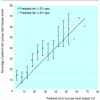Using the Framingham model to predict heart disease in the United Kingdom: retrospective study - PubMed (original) (raw)
Using the Framingham model to predict heart disease in the United Kingdom: retrospective study
S Ramachandran et al. BMJ. 2000.
No abstract available
Figures
Figure
Number of coronary heart disease events observed in the Whickham study compared with number of events predicted by Framingham model in participants with predicted risk below or above 1.5%/year. In the highest risk groups the small number of participants prevents calculation of confidence intervals
Comment in
- Guidelines on preventing cardiovascular disease in clinical practice.
Jackson R. Jackson R. BMJ. 2000 Mar 11;320(7236):659-61. doi: 10.1136/bmj.320.7236.659. BMJ. 2000. PMID: 10710556 Free PMC article. No abstract available.
Similar articles
- Predicting clinical deterioration after initial assessment in out-of-hours primary care: a retrospective service evaluation.
Hayward GN, Vincent C, Lasserson DS. Hayward GN, et al. Br J Gen Pract. 2017 Jan;67(654):e78-e85. doi: 10.3399/bjgp16X687961. Epub 2016 Nov 7. Br J Gen Pract. 2017. PMID: 27821672 Free PMC article. - The British Regional Heart Study 1975-2004.
Walker M, Whincup PH, Shaper AG. Walker M, et al. Int J Epidemiol. 2004 Dec;33(6):1185-92. doi: 10.1093/ije/dyh295. Epub 2004 Aug 19. Int J Epidemiol. 2004. PMID: 15319395 No abstract available. - Risk assessment scales for pressure ulcers: a methodological review.
Papanikolaou P, Lyne P, Anthony D. Papanikolaou P, et al. Int J Nurs Stud. 2007 Feb;44(2):285-96. doi: 10.1016/j.ijnurstu.2006.01.015. Epub 2006 Dec 4. Int J Nurs Stud. 2007. PMID: 17141782 Review. - Radiation risks from cardiovascular imaging tests.
Meinel FG, Nance JW Jr, Harris BS, De Cecco CN, Costello P, Schoepf UJ. Meinel FG, et al. Circulation. 2014 Jul 29;130(5):442-5. doi: 10.1161/CIRCULATIONAHA.113.005340. Circulation. 2014. PMID: 25070551 Review. No abstract available.
Cited by
- The accuracy of the Framingham risk-score in different socioeconomic groups: a prospective study.
Brindle PM, McConnachie A, Upton MN, Hart CL, Davey Smith G, Watt GC. Brindle PM, et al. Br J Gen Pract. 2005 Nov;55(520):838-45. Br J Gen Pract. 2005. PMID: 16281999 Free PMC article. - Health-related quality of life in diabetic people with different vascular risk.
Oliva J, Fernández-Bolaños A, Hidalgo A. Oliva J, et al. BMC Public Health. 2012 Sep 20;12:812. doi: 10.1186/1471-2458-12-812. BMC Public Health. 2012. PMID: 22994940 Free PMC article. - Increased levels of antibodies to cytokeratin 18 in patients with rheumatoid arthritis and ischaemic heart disease.
Mattey DL, Dawes PT, Nixon NB, Goh L, Banks MJ, Kitas GD. Mattey DL, et al. Ann Rheum Dis. 2004 Apr;63(4):420-5. doi: 10.1136/ard.2003.008011. Ann Rheum Dis. 2004. PMID: 15020337 Free PMC article. - New score is needed to predict risk of coronary heart disease.
Brindle P, Fahey T, Ebrahim S. Brindle P, et al. BMJ. 2002 May 18;324(7347):1217. BMJ. 2002. PMID: 12016197 Free PMC article. No abstract available. - Guidelines on preventing cardiovascular disease in clinical practice.
Jackson R. Jackson R. BMJ. 2000 Mar 11;320(7236):659-61. doi: 10.1136/bmj.320.7236.659. BMJ. 2000. PMID: 10710556 Free PMC article. No abstract available.
References
- Ramsay LE, Haq IU, Jackson PR, Yeo WW, Pickin DM, Payne JN. Targeting lipid-lowering drug therapy for primary prevention of coronary disease: an updated Sheffield table. Lancet. 1996;348:387–388. - PubMed
- Chambless LE, Dobson AJ, Patterson CC, Raines B. On the use of a logistic score in predicting risk of coronary heart disease. Stat Med. 1990;9:385–396. - PubMed
- Vanderpump MJP, Tunbridge WMG, French JM, Appleton D, Bates D, Clark F, et al. The development of ischemic heart disease in relation to autoimmune thyroid disease in a 20 year follow-up of an English community. Thyroid. 1996;6:155–160. - PubMed
- Anderson KM, Wilson PWF, Odell PM, Kannel WB. An updated coronary risk profile: a statement for health professionals. Circulation. 1991;3:356–362. . (American Heart Association statement.) - PubMed
- Kannel WB, Larson M. Long-term epidemiologic prediction of coronary disease. Cardiology. 1993;82:137–152. - PubMed
Publication types
MeSH terms
LinkOut - more resources
Full Text Sources
Medical
